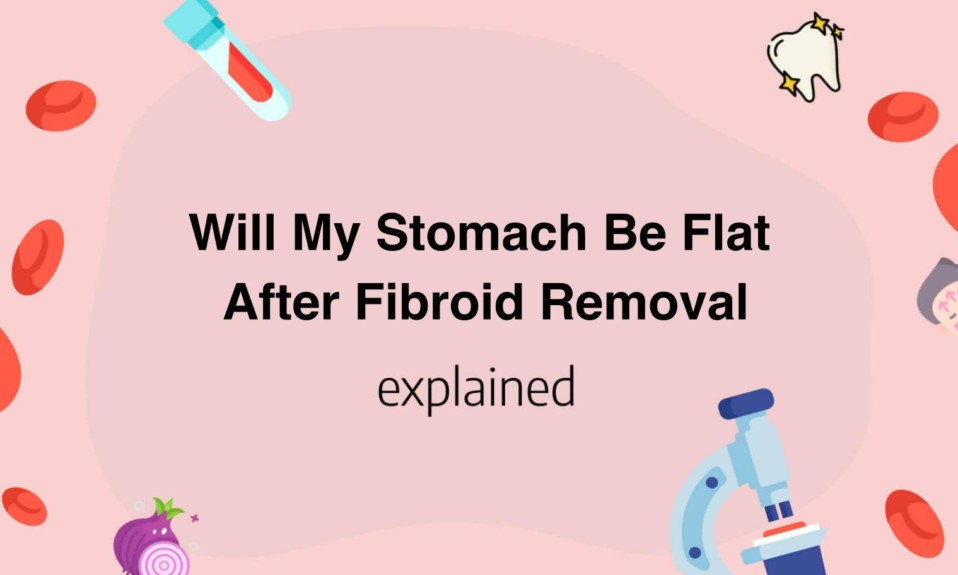If you’re experiencing fibroids, you’re probably wondering whether your stomach will return to normal after their removal.
The good news is that fibroid removal surgery can help restore a flatter stomach.
While individual results may vary, many women find that the procedure significantly reduces the size of their abdomen and improves their overall appearance.
Keep reading to learn more about what you can expect from fibroid removal surgery.
- Fibroid removal may result in a flatter stomach due to the removal of any large or multiple fibroids that were causing abdominal swelling or bloating.
- Some women may experience a reduction in symptoms such as urinary frequency or constipation that were caused by the fibroids.
- However, it is important to note that the removal of fibroids may not necessarily result in a completely flat stomach as other factors such as weight, diet, and exercise also play a role.
- Additionally, some women may still have residual swelling or bloating after the procedure due to the healing process.
- Overall, the extent of stomach flattening after fibroid removal may vary depending on individual factors and the specifics of the procedure.
Ways to Achieve a Flat Stomach After Fibroid Removal
One of the biggest concerns for patients after undergoing fibroid removal is achieving a flat stomach.
While it is common to experience bloating and swelling after surgery, there are ways to help promote a flatter tummy.
Firstly, incorporating cardiovascular exercise is essential to burning calories and losing fat around the midsection.
Aim for at least 30 minutes of moderate-to-intense cardio exercises such as brisk walking, jogging, swimming or cycling, at least 3-4 times per week.
Incorporating strength training, focusing on the abdominal muscles can also help tone and define the stomach, reducing the appearance of sagging.
Secondly, adopting a healthy and balanced diet is key to maintaining a flat stomach.
Eating a diet high in fibre and protein, while cutting down on processed foods and refined sugars, can help keep you feeling full and reduce bloating and inflammation.
Incorporating foods high in potassium such as bananas, sweet potatoes, and avocado is also recommended as it can help regulate water balance and reduce bloating.
Thirdly, practicing good posture can go a long way in reducing the appearance of a bulging belly.
Slouching and poor posture can cause the abdominal muscles to relax and protrude, giving a rounded appearance.
Practising good posture, by standing up straight, sucking in your stomach, and engaging your core can help keep your belly looking flat and toned.
In conclusion, achieving a flat stomach after fibroid removal is achievable through a combination of cardiovascular and strength training exercises, a healthy and balanced diet and practising good posture.
It is important to remember that results may take time and may require consistency and patience.
Incorporating these habits into your daily routine can not only help you achieve a flatter tummy but also promote overall physical and mental wellbeing.

Maintaining a Healthy Diet Post Fibroid Removal for a Flat Stomach
After fibroid removal, maintaining a healthy diet is essential for a flat stomach.
A balanced diet that is rich in protein, fiber, and healthy fats can help reduce inflammation, which in turn can help reduce belly fat.
Protein is an essential nutrient that helps build and repair tissues and plays a crucial role in weight loss.
Incorporating lean protein sources like chicken, fish, lean cuts of meat, and legumes can help keep you feeling full and satisfied while supporting muscle growth.
Fiber is another essential nutrient that helps move things through the digestive system and maintain regularity.
Incorporating fiber-rich foods like fruits, vegetables, whole grains, and legumes can help reduce bloating and promote a healthy gut.
Additionally, foods high in fiber tend to be low in calories, making them an excellent option for weight loss.
Healthy fats are also crucial for overall health and can play a role in reducing belly fat.
Focusing on healthy fat sources like nuts, seeds, avocado, and olive oil can help support heart health, prevent inflammation and aid in weight management.
Furthermore, it’s essential to avoid processed foods, sugary beverages, and alcohol as they contribute to inflammation and weight gain.
These types of foods are often high in calories, unhealthy fats, and added sugars, and can lead to bloating and digestive issues.
In conclusion, post fibroid removal, maintaining a healthy diet is key to achieving a flat stomach.
Focusing on lean protein sources, fiber-rich foods, and healthy fats while avoiding processed and sugary foods can help reduce inflammation, keep you feeling full, and support healthy weight management.
Incorporating these foods into a balanced and nutrient-rich diet with regular exercise can lead to a healthy and sustainable lifestyle.
Will My Stomach Be Flat After Fibroid Removal
After fibroid removal, it is normal to wonder if your stomach will be flat.
The answer, however, is not a straight yes or no.
It depends on various factors, such as the size and number of fibroids removed, the surgery type, and your body’s healing process.
Typically, you may experience some bloating and swelling after the surgery, which can temporarily affect your stomach’s appearance.
However, with proper postoperative care and a balanced diet, you can aid your body in healing and maintaining a flat stomach.
Firstly, it is essential to follow your surgeon’s instructions thoroughly.
They may advise you to avoid strenuous activities and heavy lifting for several weeks to allow your body to recover adequately.
Doing too much too soon can cause swelling and inflammation, which can impede your body’s healing process and cause bloating.
Secondly, incorporating high-fiber foods, such as fruits, vegetables, and whole grains, can help regulate digestion and prevent constipation, which can lead to bloating.
Drinking plenty of water and reducing sodium intake can also reduce bloating.
Thirdly, exercising regularly can help tone your abdominal muscles and prevent fluid buildup, which contributes to bloating.
Low-impact exercises like walking, light yoga, and swimming can aid in recovery while promoting a flat stomach.
In conclusion, while fibroid removal surgery may cause temporary bloating and swelling, following proper postoperative care and adopting healthy lifestyle habits can help you achieve a flat stomach.
However, it is essential to remember that every person’s healing process is different, and you may need to be patient with your body’s response to surgery.
Always consult with your healthcare provider if you experience any unusual symptoms or concerns.
The Role of Exercise in Achieving a Flat Stomach After Fibroid Removal
Regular exercise is essential in achieving a flat stomach after fibroid removal.
Fibroid removal surgery is a complex procedure, which can leave you with swelling, soreness, and weakness around the abdominal muscles.
To avoid complications, doctors often recommend waiting for at least 6 to 8 weeks before engaging in any strenuous physical activity.
However, light exercise can help to reduce swelling and improve strength and flexibility during the recovery process.
Low-impact cardio exercises, such as walking, cycling, and swimming can improve heart health and increase metabolism.
As you heal, you can gradually increase the intensity and duration of your cardio workouts.
For instance, start with a 20-minute leisurely walk or gentle swim and build up to a 45-minute moderate-intensity workout.
Core strengthening exercises, such as yoga and Pilates, can help to tone and strengthen the abdominal muscles, making it easier for you to achieve a flat tummy.
These exercises target the deep core muscles, including the transverse abdominals, which are often neglected in traditional workouts.
They also promote good posture and reduce the risk of developing lower back pain.
In addition to cardio and core strengthening exercises, resistance training can help to build muscle mass and burn excess fat.
Muscle tissue requires more energy to maintain than fat tissue, which means that the more muscle mass you have, the higher your metabolism and the easier it is to lose weight.
Examples of resistance exercises include weight lifting, squats, and lunges.
In conclusion, exercise plays a crucial role in achieving a flat stomach after fibroid removal surgery.
However, it is essential to listen to your body and avoid overexerting yourself.
Always consult with your doctor or physical therapist before starting any new exercise routine and follow their advice.
With consistent effort and patience, you can achieve a flat tummy and optimal health after fibroid removal surgery.
Read also: Is Bowel Leakage A Sign Of Cancer
Understanding the Relationship Between Fibroids and Stomach Bloating After Removal
Although rare, a common side effect of fibroid removal surgery is stomach bloating.
This is because, during the operation, a lot of gas is pumped into the abdominal area to inflate it and create space for the surgeon to work.
This gas can take a while to dissipate, causing discomfort and bloating.
However, this is usually temporary and should subside within a few days or weeks.
If the bloating persists for a prolonged period or becomes painful, it may be an indication of a more serious complication.
Internal bleeding or infection can both cause bloating and may require immediate medical attention.
It is important to monitor any symptoms and consult a doctor if you are concerned.
In most cases, stomach bloating after fibroid removal can be relieved through a number of home remedies.
Drinking plenty of water can help flush out the excess gas and reduce bloating.
Gentle exercise, such as taking a walk or practicing yoga, can also help to move the gas out of the abdominal area.
Dietary changes can also be beneficial.
Eating smaller, more frequent meals and avoiding foods that are known to cause bloating, such as beans, cruciferous vegetables, and carbonated drinks, can help to reduce discomfort.
Some foods that are known to help ease bloating include ginger, peppermint, and chamomile tea.
In summary, stomach bloating is a common side effect of fibroid removal surgery, but usually temporary.
It is important to monitor symptoms and seek medical attention if concerned about complications.
Drinking water, exercising, and making dietary changes can help alleviate discomfort.
Read also: Iritis Vs Conjunctivitis
The Importance of Post-Operative Care for a Flat Stomach After Fibroid Removal
Post-operative care after *fibroid removal surgery* is critical for successful outcomes.
Women who experience uterine fibroids can feel a sense of relief knowing they have undergone a necessary surgery to remove them, but the process does not end there.
For those hoping to maintain a flatter stomach after *myomectomy* or *hysterectomy*, adequate post-operative care is important.
Hydration is key to ensuring that the body recovers well.
It is essential to drink plenty of water and other hydrating drinks like coconut water, celery juice, or herbal teas.
Water helps to flush out toxins from the body and reduce swelling in the treated area, leading to a better recovery process.
A healthy diet is also crucial, and vitamin C, in particular, can be beneficial for the healing process.
Foods high in vitamin C may include citrus fruits, strawberries, bell peppers, and leafy greens, among others.
Patients should also aim to consume enough protein to support the body in rebuilding muscle and tissue.
Lean meats like chicken, fish, and turkey, as well as vegetarian sources like beans and legumes, are excellent sources of protein.
Another key component of a successful recovery is physical activity.
While rest and relaxation are crucial during the initial recovery period, low-impact exercise can help reduce inflammation and promote healing.
Options like walking, stretching, and light yoga can support the body in regaining strength and flexibility.
In addition to these key components, patients should make sure to follow their surgeon’s specific instructions for post-operative care.
These may include avoiding heavy lifting, wearing compression garments, and taking pain medication as prescribed.
If there are any concerns or questions during the recovery process, it is essential to reach out to the surgeon or medical team for guidance.
Proper post-operative care can go a long way in helping patients achieve their goals for a flatter stomach after fibroid removal surgery.
You’ll also like:










